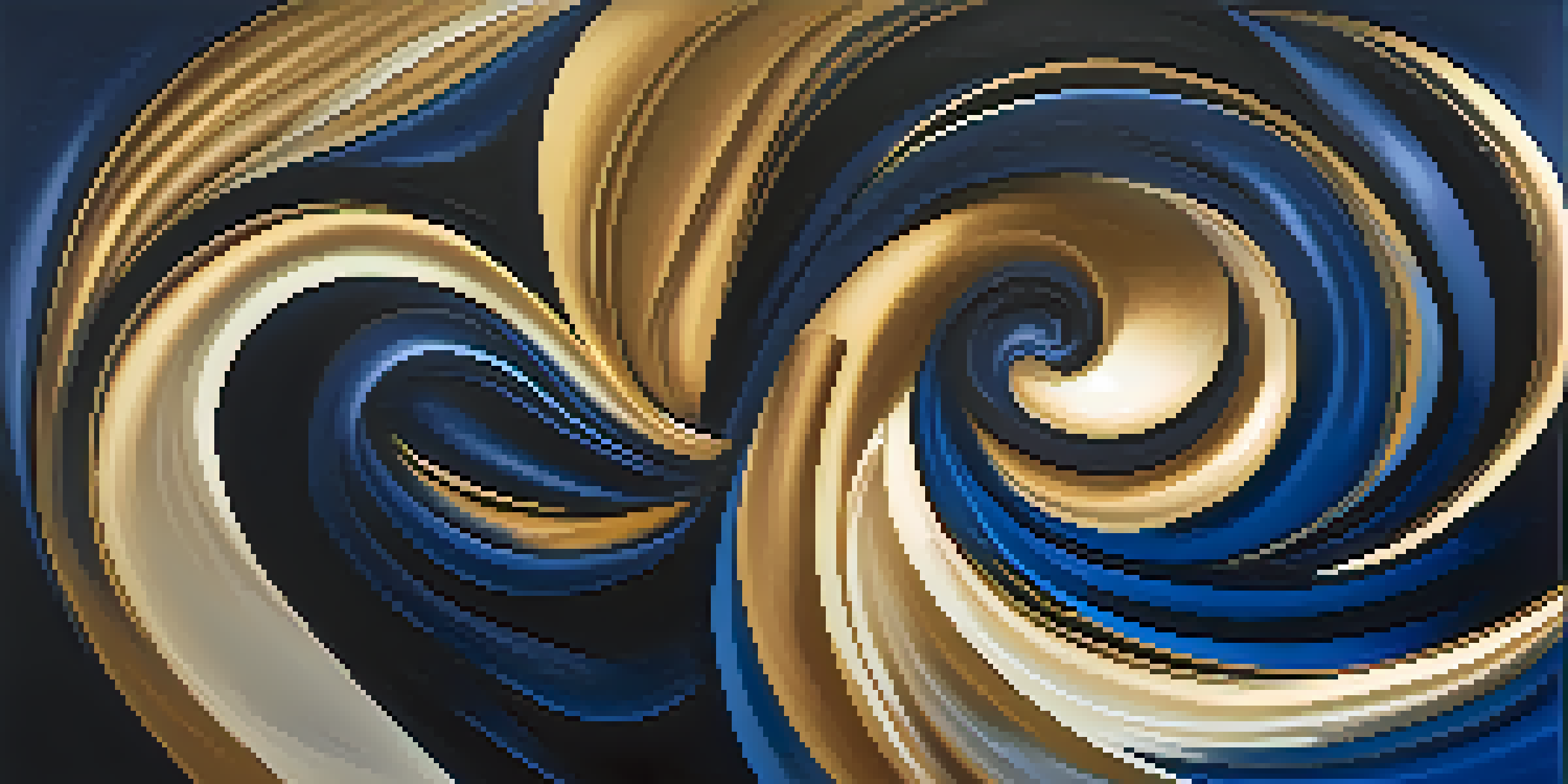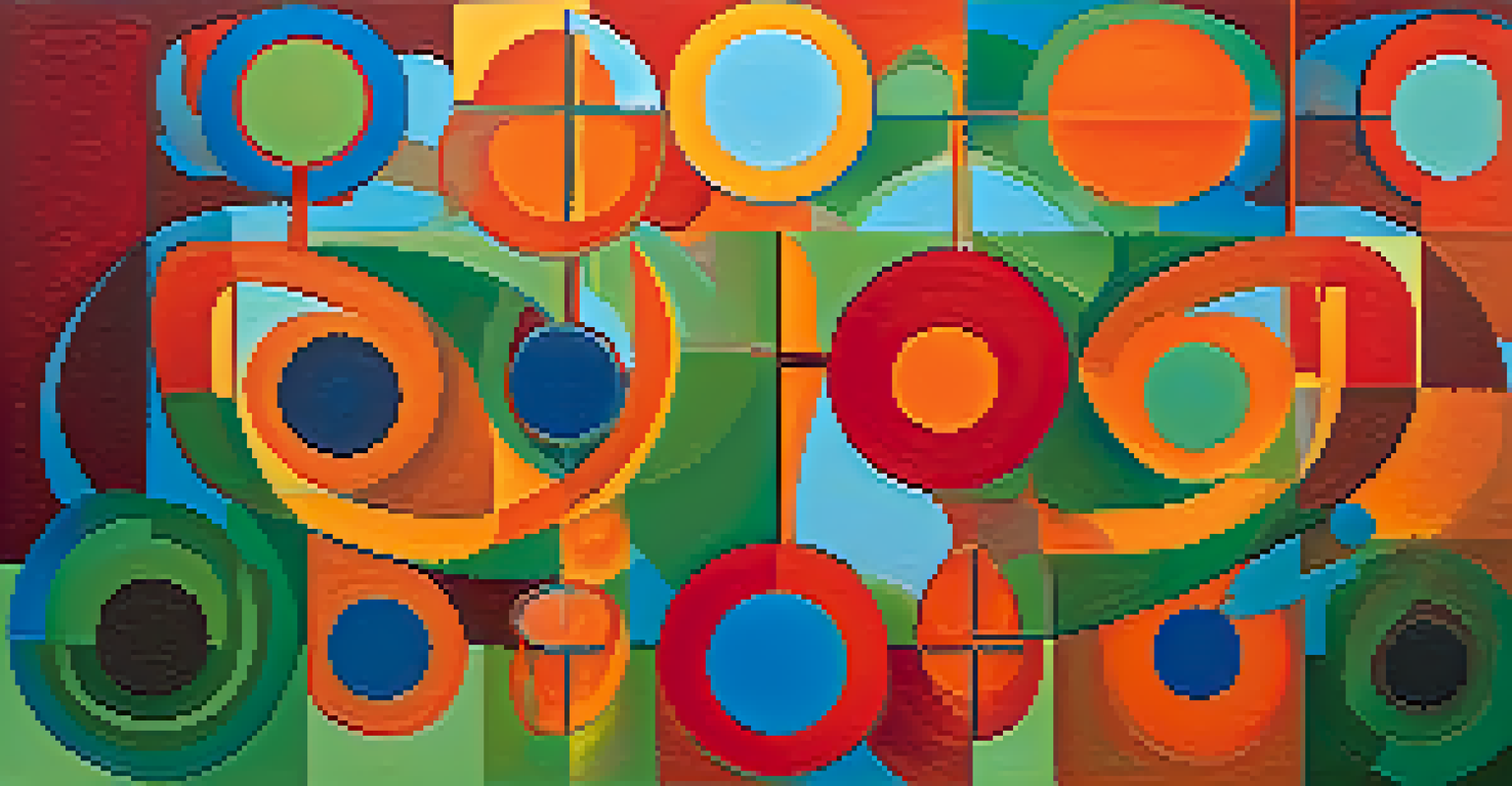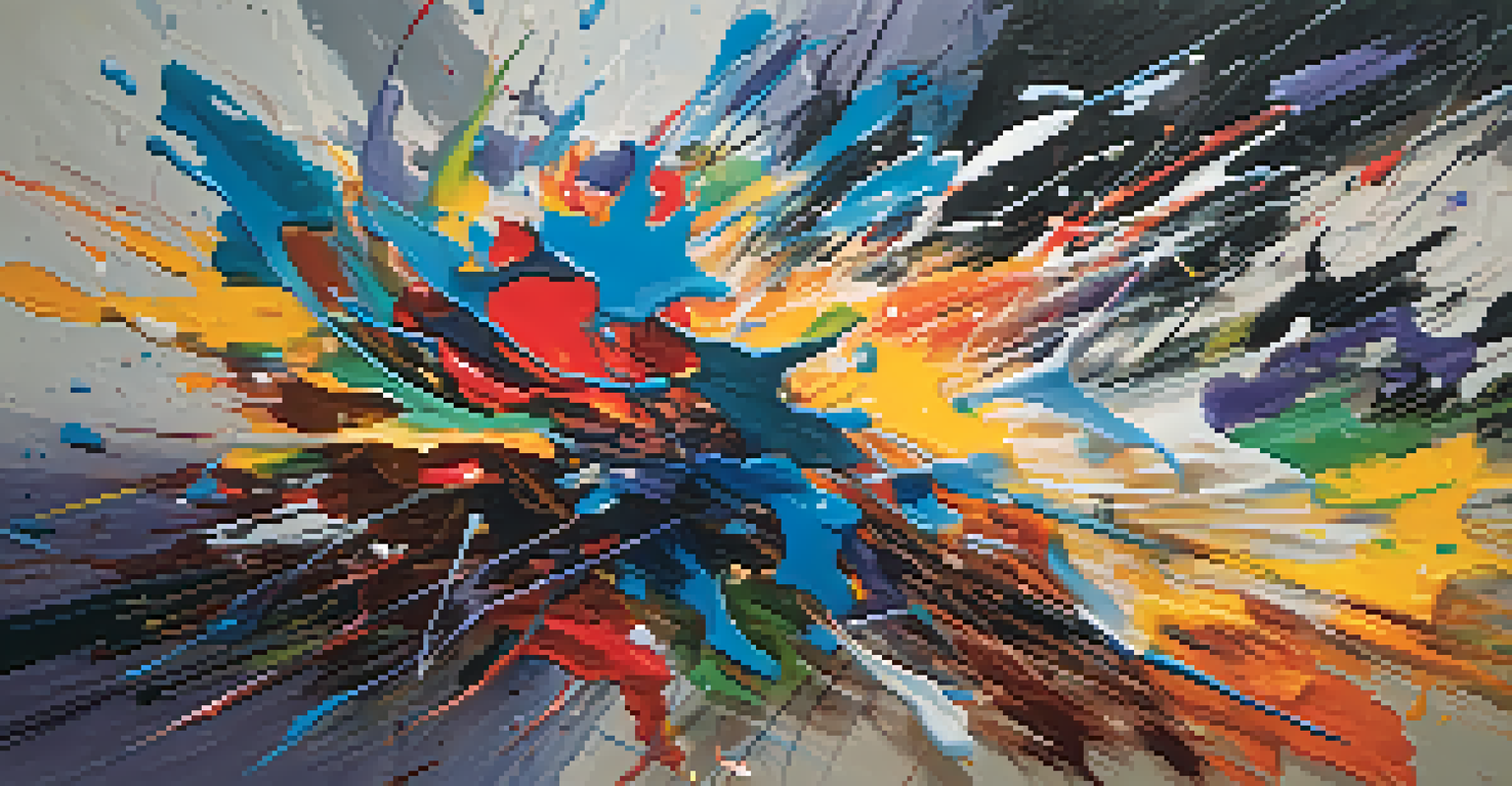The Intersection of Abstract Art and Spirituality

Understanding Abstract Art: A Gateway to Emotion
Abstract art strips away the recognizable elements of reality, allowing artists to express their emotions and ideas in a pure, unfiltered way. By doing so, it invites viewers to engage with the artwork on a personal level, often prompting emotional and spiritual reactions. Just as a melody can evoke feelings without words, abstract art communicates through colors, shapes, and forms, creating a unique dialogue between the artist and the observer.
Art is the most beautiful of all lies.
For instance, consider a swirling canvas of blues and golds; it might evoke feelings of tranquility or evoke a moment of introspection, leaving viewers to ponder their own experiences. This emotional resonance is where art transcends its physical form, becoming a pathway to deeper understanding. It challenges us to look beyond the surface and delve into the feelings and thoughts that arise within us while experiencing the art.
Thus, abstract art serves as more than just decoration; it acts as a mirror reflecting our inner landscapes. In this way, it lays the foundation for exploring the spiritual dimensions of creativity, inviting us to question the nature of existence and our place within it.
Spirituality Defined: More than Just Religion
Spirituality often encompasses a broad spectrum of beliefs and practices, extending beyond organized religion. It invites individuals to explore their connection to the universe, nature, and the deeper aspects of life. This exploration can manifest in various ways, including meditation, mindfulness, and personal reflection, all of which encourage a sense of inner peace and clarity.

For many, spirituality is a personal journey that may involve seeking meaning in everyday experiences. It encourages a dialogue between the self and the cosmos, fostering growth and understanding. This quest for meaning can align beautifully with the emotive qualities found in abstract art, where the search for deeper truths often lies beneath the surface.
Abstract Art as Emotional Expression
Abstract art allows artists to convey deep emotions and ideas, inviting viewers to engage on a personal and spiritual level.
By recognizing spirituality as an individual pursuit, we open the door to a more inclusive understanding of what it means to seek connection and purpose. This foundational idea allows us to see how abstract art can serve as a catalyst for spiritual exploration and expression.
The Power of Color and Form in Spiritual Expression
Color and form in abstract art can carry significant weight in spiritual expression, often conveying emotions or concepts that words fail to capture. For example, warm colors like red and orange might evoke feelings of passion and energy, while cool colors like blue and green may inspire calmness and reflection. Artists often choose their palettes intentionally to evoke specific feelings, which can resonate with viewers on a spiritual level.
The more I paint, the more I realize that I am a part of the universe and the universe is a part of me.
Similarly, the shapes and forms within an artwork can symbolize various ideas, such as growth, harmony, or chaos. A circle may represent wholeness or eternity, while jagged lines might suggest turmoil or struggle. This interplay of color and form allows abstract art to communicate complex spiritual themes, making it a powerful medium for exploration.
As viewers engage with these visual elements, they're invited to interpret the artwork through their own spiritual lens. This dynamic interaction allows for a diverse range of interpretations, demonstrating how abstract art can serve as a unique vehicle for personal and collective spiritual journeys.
Interpreting Abstract Art: A Personal Journey
Interpreting abstract art is inherently subjective, with each viewer bringing their own experiences and perspectives to the encounter. This personal interaction is where the magic happens; as we stand before a piece, we are invited to reflect on our own emotions, thoughts, and spiritual beliefs. Each brushstroke or color choice can evoke different responses, leading us to new insights about ourselves.
For instance, one person might see a chaotic swirl of colors as a representation of life's struggles, while another might interpret it as a celebration of freedom and expression. This variability highlights the fluid nature of abstract art and its ability to tap into our individual spiritual journeys. It encourages us to explore our feelings and confront our thoughts in a safe and open space.
Spirituality Beyond Religion
Spirituality encompasses personal journeys that connect individuals to the universe, fostering growth and understanding through exploration.
Ultimately, this personal journey of interpretation deepens our understanding of both the artwork and ourselves. It reminds us that there is no right or wrong way to experience art; instead, it's about the connection we build with the piece and the revelations that arise from it.
Cultural Perspectives on Art and Spirituality
Different cultures have long intertwined art and spirituality, each bringing unique interpretations and practices to the relationship. In many indigenous cultures, for example, art is often a spiritual practice, with artists creating works that reflect their beliefs, traditions, and connections to the earth. This deep-rooted connection illustrates how art can serve as a bridge between the physical and spiritual realms.
Similarly, in Eastern philosophies, art forms like calligraphy and painting often emphasize the meditative process, transforming the act of creation into a spiritual journey. Artists become conduits for expressing universal truths, allowing their work to resonate with viewers on a spiritual level. This cross-cultural understanding enriches our appreciation of abstract art and its potential to convey spiritual themes.
By examining these diverse cultural perspectives, we can gain a broader understanding of how spirituality shapes artistic expression. It also invites us to reflect on our own cultural backgrounds and how they influence our interpretations of abstract art, enhancing our personal spiritual journeys.
Abstract Art as a Tool for Spiritual Healing
Many people find solace in creating or engaging with abstract art as a form of spiritual healing. The process of making art can be therapeutic, allowing individuals to express feelings that are difficult to articulate. This creative outlet offers a space for reflection and emotional release, often leading to profound personal insights and healing.
Art therapy, for example, utilizes this principle by encouraging participants to explore their emotions through creative expression. Research has shown that engaging in artistic activities can reduce anxiety, improve mood, and foster a sense of connection to oneself and the world. This therapeutic aspect aligns closely with spiritual practices, which also aim to promote well-being and inner peace.
Art as a Healing Tool
Engaging with abstract art can serve as a therapeutic outlet, promoting emotional release and spiritual healing.
Thus, abstract art becomes not just a medium for expression but also a pathway to healing. By embracing creativity, individuals can embark on a journey of self-discovery and spiritual growth, ultimately leading to a more balanced and fulfilling life.
Conclusion: The Ongoing Dance of Art and Spirit
The intersection of abstract art and spirituality reveals a vibrant tapestry of human experience, creativity, and emotion. As we navigate this space, we find that art can serve as a powerful tool for exploration, reflection, and healing, connecting us to our inner selves and the world around us. This ongoing dance between art and spirit invites us to embrace our own journeys and seek deeper understanding through creative expression.
By recognizing the significant role that abstract art plays in spiritual exploration, we honor the many ways in which creativity enhances our lives. Whether we are artists or viewers, we have the opportunity to engage with art as a means of connecting with our emotions, beliefs, and the universe itself. This relationship ultimately enriches our spiritual journeys, fostering growth and understanding.

As we continue to explore this intersection, let us remain open to the possibilities that arise from engaging with abstract art. Each piece offers a unique invitation to delve into the depths of our own spirituality, encouraging us to seek meaning, connection, and inspiration in every brushstroke.